Last week during my experiments with glucose syrup, I came across this recipe for Glucose Syrup Butterscotch Bars. Actually, that's just what I'm calling them to distinguish them from all the other brown sugar type bars. They are really called Butterscotch Bars, and the recipe is from the Heny Sison culinary school in Manilla.
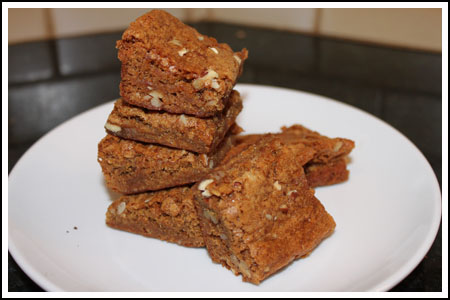
The bars are made with brown sugar, butter, etc. However, in addition to the usual ingredients they call for glucose syrup. It is supposed to increase moisture and prolong freshness.
Glucose Syrup and Freshness Test
Saturday I baked a modified half batch and put them in a sealed tin to see how they would hold up. Today (Monday), I checked the results and they still taste great!
There are lots of butterscotch bar recipes and chances are you have a good one, but if you need something that will stay fresh for a few days, adding some glucose syrup is worth a try. I finished off my jug of Wilton glucose syrup but am fairly certain honey, golden syrup or corn syrup would have worked very well too.
Taste and Texture
As for taste and texture, adding syrup to the bars made them a little softer than usual. And they are moist, but not cakey. My batch didn’t rise very high, but for Butterscotch Bars that’s a good thing because they are supposed to be dense. I browned the butter and got a really good burnt caramel/brown butter flavor which combined with pecans is always good. So overall, I liked these a lot and am happy to have another make-ahead or shippable recipe.
I'm looking forward to trying glucose syrup in other things and will be posting some more experiments soon. In the comment section of a recent post, a visitor from a professional cookie bakery gave us a tip on how to make it at home, and I've got my special homemade batch of glucose syrup in the refrigerator right now.
Recipe

Stay-Fresh Butterscotch Bars
Ingredients
- 1 cup all-purpose flour plus 1 T. (134 grams)
- ½ teaspoon baking powder
- ¼ teaspoon baking soda
- ½ scant teaspoon Kosher salt Morton – use half if using salted butter
- ¼ cup unsalted butter (56 grams)
- ¼ cup liquid glucose
- ¾ cup packed light brown sugar (150 grams)
- ½ teaspoon vanilla extract
- 1 large egg
- ⅓ cup coarsely chopped toasted pecans
Instructions
- Preheat oven to 325°F and line an 8 inch square metal pan with aluminum foil. Grease foil and set pan aside.
- Sift or stir together flour, baking powder, baking soda and salt; Set aside.
- Melt butter over medium heat in a small saucepan. Cook just until it starts to brown, then remove from heat and transfer to a medium size mixing bowl. Let cool slightly. Add brown sugar, glucose and vanilla extract. Beat with a hand-held electric mixer on medium speed until combined. Add the egg and beat on high speed for about 3 minutes or until the egg is fully incorporated and the batter is lighter in color and texture. By hand, stir in the flour mixture and nuts; Spread in prepared pan (damp fingertips help).
- Bake for 30 minutes until top is firm. Cool on wire rack. Cut into bars.

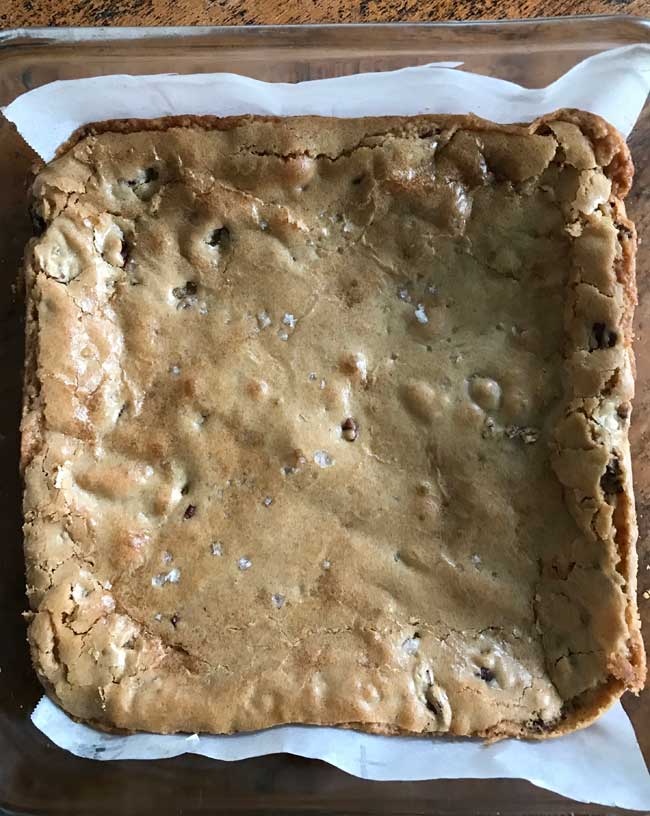
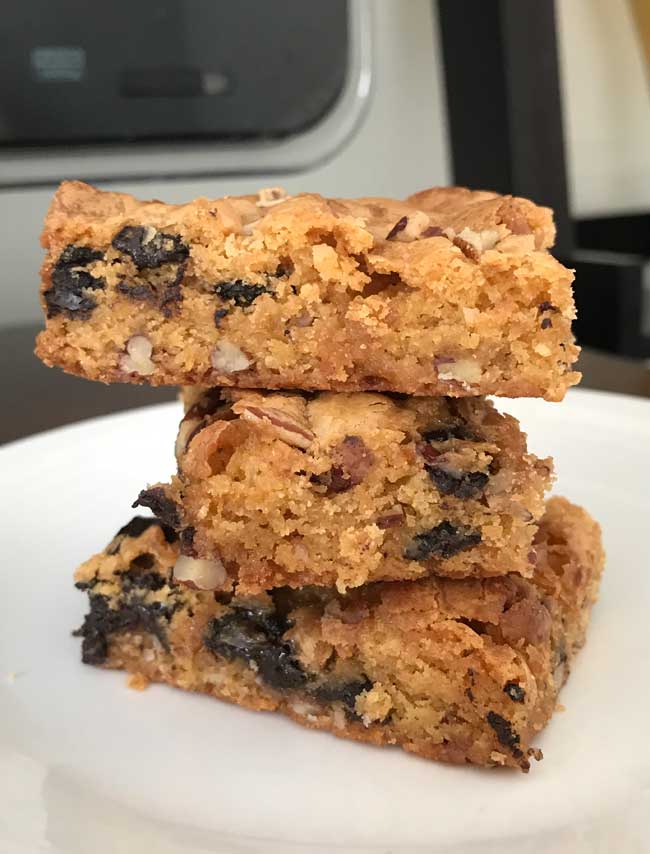
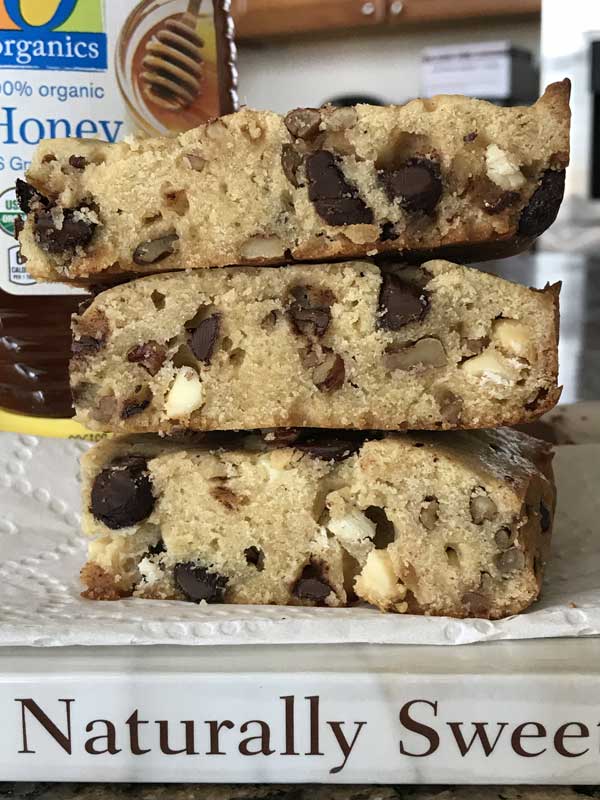
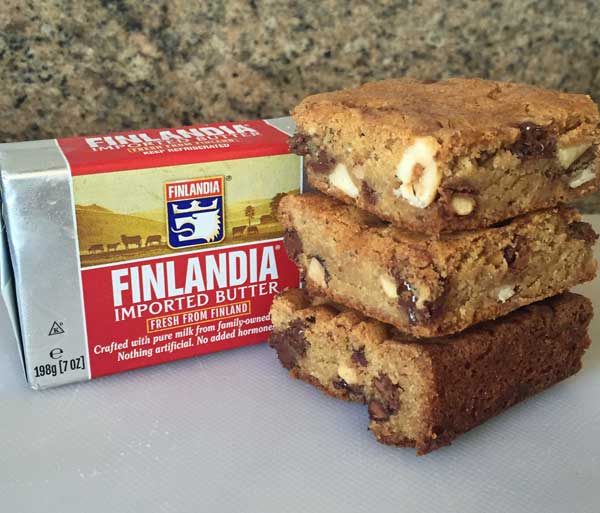
Anna says
Hi Melanie,
You might want to just use a different butterscotch bar. This one's really good.
https://www.cookiemadness.net/?p=3427
If you do use this one and omit the syrup, try adding another 3 packed tablespoons brown sugar. I think that would work.
Melanie says
I'd like to make this recipe without the glucose syrup. Would I need to add more sugar in its place or is it ok to only omit the syrup? Thanks!
Maria says
I need to bake with butterscotch more often. These bars look fantastic!
Dolce says
I don't really need to have the bars stay fresh for long, because, er... I eat them pretty fast... 😉 But that's a good idea, thank you!
Anna says
I'm pretty sure Lyle's would be a great substitute for the glucose syrup used here and in those chocolate chips cookies. I think Lyle's would be more like a glucose syrup, but it is made with invert sugars. Honey also has invert sugars.
The invert syrup is something I made by boiling sugar with water and adding lemon. I haven't used it yet, but it's supposed to have preservative qualities as well.
But back to glucose syrup. When I put the Wilton glucose syrup in the chocolate chip cookies, they cooled down and had very crispy (almost hard) edges and a chewy center. However, after sitting in a covered tin for a day they were chewy. A lot of the crispiness was gone if I recall, but it could have just been that recipe which also had a lot of brown sugar. They still tasted good, but they did lose their crispiness on Day 2.
I'm probably going to try the invert sugar syrup in a brownie recipe.
Meanwhile, I've been reading the differences between invert sugar and glucose syrup. This is a good reference.
http://www.apitco.org/Profiles/Liquid%20glucose%20and%20Invert%20sugar.pdf
Both can be used as preservatives.
Anna says
Comment from Liang
"If what we're talking about is invert syrup, then would Lyle's Golden syrup be a decent substitute as well? I have a bottle of it lying around, and according to Wikipedia, it's made in the same fashion as the homemade recipe your reader commented about (heating sugar with acid and water): http://en.wikipedia.org/wiki/Golden_syrup
I've been following these glucose syrup escapades with a lot of interest as I am always trying to find ways to make those CCC more chewy, hehe. But on the flip side, are you sacrificing the contrast of crispy edges to get the long-lasting softness?"
Katrina says
I'd have to really think about all this to process it all. 😉
But the bars look good and even better if they taste good days later!
Anna says
Sam, the way I understand it is the body breaks food down into glucose so if you eat too many calories, you're probably getting too much glucose.
What I'm trying to wrap my head around is glucose syrup vs. corn syrup vs. all the other glucose syrups that are not made of corn in baking. And now I have a new syrup to add to the mix - inverted sugar syrup.
NOTE TO EVERYONE
I'm having problems with my spam filter today, so if you try to post a comment and it doesn't "take", just forward it to anna at cookie madness dot net and I'll post it for you.
This comment is from Rose.
"I tried to post this as a comment, but for some reason the site thought it was spam, probably because of the excessive use of punctuation. According to "Chocolates and Confections: Formula, Theory, and Technique for the Artisan Confectioner," glucose syrup can be made from any number of grains, and can be labeled either using the general term (i.e. glucose syrup), or, by the type of grain used to produce the glucose syrup (e.g. corn syrup). In other words, they're the same thing, except that (at least in my experience) Wilton's glucose syrup is substantially more expensive."
Roses's comment has me wondering why Martha Stewart and C. Tossi used thick, sticky glucose for the Blueberry Creme cookies and didn't just use corn syrup and why is Wilton's glucuse (made from corn syrup) so very different in texture and viscosity from regular corn syrup which is just another form of glucose.
To make matters more confusing, it seems the recipe I was given for stay-fresh glucose syrup (the one in the comment section after the link) is actually inverted sugar syrup which is also a preservative (Hooray!) but not the same as glucose syrup.
So it seems I've used up all my expensive glucose syrup and have made myself a batch of inverted syrup.
Sam Kathryn says
Do you know I'd the consumption if glucose is healthy in large doses? I know that it's just another form of sugar, but I was just wondering.
By the way, I love the smell of butterscotch! Yum 🙂